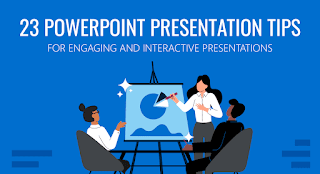Creating Engaging Presentations with Educational Presentation Tools
Introduction: In today's digital age, educators have a powerful ally in their quest to engage students and deliver memorable lessons: educational presentation tools. These dynamic software platforms go beyond the traditional slideshow, enabling teachers to create interactive and visually captivating presentations. In this blog, we'll explore how educators can harness the potential of these tools to make learning more engaging and effective.
Table of Contents:
The Evolution of Educational Presentations
- Discuss the transition from static PowerPoint slides to interactive, multimedia-rich presentations.
Choosing the Right Educational Presentation Tool
- Explore popular options like Google Slides, Prezi, and Microsoft Sway, highlighting their unique features and benefits.
Designing Interactive Lessons
- Provide tips on creating engaging lessons with animations, embedded videos, and interactive elements.
Engaging Visuals: Beyond Bullet Points
- Explain the importance of visual storytelling and share design best practices for effective presentations.
Collaborative Learning with Presentation Tools
- Showcase how these tools facilitate collaboration among students, allowing them to create and present their projects.
Assessment and Feedback Integration
- Discuss how presentation tools can be used for formative assessments and gathering feedback from students in real-time.
Accessibility and Inclusivity
- Address the importance of creating presentations that are accessible to all students, including those with disabilities.
Practical Classroom Applications
- Share real-life examples of how teachers are using presentation tools to enhance their lessons and engage students.
Free vs. Paid Presentation Tools: Pros and Cons
- Compare free and paid versions of popular presentation tools and help educators choose the right option for their needs.
FAQs: Your Presentation Tool Questions Answered
- Address common questions teachers may have about using presentation tools, including troubleshooting issues and integrating them into the curriculum.
Conclusion: Educational presentation tools have transformed the way teachers deliver content and engage students in the learning process. By choosing the right tool and incorporating interactive elements, educators can create presentations that leave a lasting impact on their students.
SEO-Friendly Tips:
- Use relevant keywords such as "educational presentation tools," "interactive lessons," and "engaging visuals" throughout the blog.
- Include internal and external links to reputable sources for additional information.
- Optimize images with descriptive alt text.
- Keep paragraphs and sentences concise and scannable for readers.
- Use subheadings, bullet points, and numbered lists for improved readability.
FAQs:
Q1: Are these presentation tools suitable for all grade levels?
- Yes, presentation tools can be adapted for use in kindergarten through higher education. The key is tailoring your content to the age and comprehension level of your students.
Q2: Can I use presentation tools for remote teaching and online classes?
- Absolutely. Many presentation tools offer online collaboration features, making them ideal for remote learning environments.
Q3: Are there any free alternatives to paid presentation tools?
- Yes, some presentation tools offer free versions with limited features. However, if you require advanced features, you may want to consider a paid subscription.
Q4: How can I ensure that my presentations are accessible to all students?
- To make your presentations accessible, use headings, alt text for images, and provide transcripts for videos. Most presentation tools also have accessibility features built in.
Q5: Can I export and share presentations easily with my students?
- Yes, presentation tools usually allow you to export your presentations in various formats, such as PDF or shareable links, making it simple to distribute them to your students.



Comments
Post a Comment